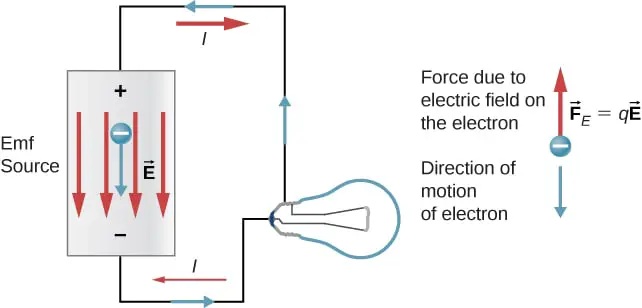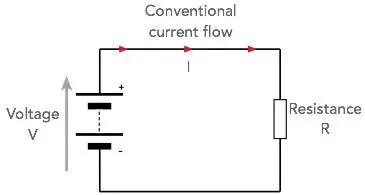Electromotive force and voltage are terms that are sometimes used interchangeably but there is a difference between them. These terms are also sometimes confused with electromagnetic fields. Although they are all related, they are not the same. We often hear that exposure to electromagnetic fields can have negative impacts, but how are they created? Electromotive force and voltage are directly related to the production of electromagnetic fields (EMF).
Electromotive force is an invisible form of energy produced by the interaction of both electric and magnetic fields. This force is a result of the movement of electrons from one point to another. Electromotive force is measured by voltage (V). As the current flows through the wires, it generates an electromagnetic field (EMF). The higher the current, the higher the electromagnetic field. Electromagnetic fields can have a frequency, which is measured in Hertz (Hz), with a strength measured in milliGauss (mG), or microtesla (µT).
When the current flows, the electromotive output is different from the voltage output. The electromotive force causes the charge to move from the negative to the positive within the source, like in a battery; whereas the voltage is what causes the electrons to move from the positive end to the negative end of the source through an external wire.
Therefore, the electromotive force requires current and voltage to enable the separation of electrons.
Watch this video for the summary, then read the article for the details. Hope you enjoy!
What Is The Electromotive Force?
Electromotive force uses non-electrical sources to convert other sources of energy into electrical energy, for example, a battery converts chemical energy or a generator converts mechanical energy.
If a battery is used, separating the charged objects gives rise to a voltage difference between the terminals of the chemical reaction, thus converting the chemical energy into potential electromagnetic energy.
An electrical generator uses a magnetic field to generate electron movement, which creates a voltage and thus an electromagnetic field through electromagnetic induction. As a result, a voltage difference is created between the generator terminals. As charge separation within the generator occurs, electrons flow away from one terminal into another terminal until enough electrical field is produced to enable further separation of charges.
How is electromotive force formed?
Electromotive force is formed through electrically charged objects like electrons. Separating electrons from atoms using other sources of energy results in more electrically charged objects.
Because the amount of energy in the sources determines the electromotive force generated, the charges produced can be both positive and negative. Therefore, electromotive force is the amount of energy supplied to a unit charge by the battery. That is, the energy required to separate the charge carriers from an electrical current source.
Electric devices like a generator maintain the current flowing through the circuit and convert other energy forms to electrical energy.
The electromotive force of the circuit (E, measured in volts) is calculated as follows:
E=I*(R+r)
Where, I is the flow of current, R is Load resistance, and r is internal resistance.

If the device doesn’t have an internal resistance, and the charge that passes through the device gains some energy, then the electromotive force of the device is the energy gained per unit charge. That charge is measured in coulombs while the electromotive force itself is measured in volts.
You can learn more on the electromotive force here.
What Is Voltage?
Voltage is the energy that moves an electric charge from one point to another. The voltage is the measure of potential difference between two points in a circuit. It is measurable in a cell immediately upon the circuit’s activation. The energy produced is a result of the interaction between the electrical field and the magnetic field.

As the current moves from one point to another, it produces a magnetic field. If the charge is stationary, it produces an electric field when measured to another point. A changing magnetic field can also produce an electric field.
The charge can either be positive or negative. When there are fewer electrons in the positive terminal than in the negative terminal, a potential difference is formed in the electrical state of the source terminal.
The force formed as the electrons move from one point to another in a closed circuit results in an electrical voltage. This electrical voltage is equivalent to an electrical force needed to move current from one point to another.
The force can also affect the behavior of other non-moving charged objects. Objects with different charges form an attractive force between them, while those with the same charge form a repulsive force.
Therefore, the greater the charge in a circuit, the greater the force between the charged objects.
Point A of a battery is the positive terminal, and point B is the negative terminal, so when they are connected, they have a potential difference. That difference is measured in voltage.
The Difference Between EMF And Voltage Explained
| Nr. | Comparison | EMF | Voltage |
| 1. | Definition | Electromotive force is the amount of voltage available in a particular electric source. | Voltage is the energy produced when a charge passes through a circuit from point A to point B. Voltage is the force necessary to move a charge from a more positive point to a more negative point. |
| 2. | The force of operation | It uses non-electric force operation which helps in increasing the energy in a circuit. | Uses electric force to charge particles and it results in a reduction of energy in a circle. |
| 3. | Induction | It causes both gravitational, magnetic and electric fields. | The voltage in the wires can only induce electric fields. |
| 4. | Movement of charge | Produced through moving charges (current) | It produces electric fields through stationary charges. |
| 5. | Measurement | Electromagnet force doesn’t rely on circuit resistance. It measures the distance between the endpoints when there is no charge flowing through it. It uses an EMF meter to measure the force in two endpoints. | The voltage of the current is directly dependent on the resistance between two points of measurement. It measures the potential difference between two points. Voltage is measured by a voltmeter. |
| 6. | Symbol | E | V |
| 7. | Formula | E=I*(R+r) | V=I*R |
| 8. | Potential difference | It has the highest potential difference when there is no current flowing through it. This is because EMF has a constant magnitude. | The potential difference of a voltage is lower than that of electromotive force. This is because of the resistance that exists. |
| 9. | Current generation | If the circuit uses an electrical generator to drive current through a resistor, then the EMF will have time-varying magnetic fields inside the generator. These magnetic fields will generate an electrical voltage needed to generate current. | In a complete circuit than consists of a resistor and voltage cell, the electrical voltage in that circuit doesn’t contribute to the overall EMF since the voltage difference generated is zero. |
How Potential Difference Contributes To The Dispersion Of Energy?
Separation of an electric charge creates an electric potential difference. A voltmeter can be used to measure the voltage between the terminals of the electric device. The electromotive force within a battery or any other energy source is equivalent to the voltage value of its open circuit.
If the battery is charging, you can measure the electromotive force directly using the external voltage.
The potential difference between two points provides a continuous flow of current in a circuit. For example, a battery provides a steady flow of current as long as there is a potential difference. The flow of current from a higher potential to a lower potential converts the electrical energy to other forms like light and heat.
Current flowing through the conductor is met with resistance. The energy derived from the battery overcomes this resistance, and it’s distributed as heat and other forms of energy.
How Does Electromotive Force and Voltage Relate to Electromagnetic Fields?
The interaction of the electric and magnetic fields results in an electromagnetic field. As the current flows between connected electrical devices, it increases the electromagnetic field. If the current increases, the electromagnetic field increases its strength. This field is like a wave of energy radiating away from the source of the field. This is what people refer to as EMF radiation.
When the distance of a magnetic field increases away from its source, the strength of the magnetic field decreases. If the voltage in a cell increases, the electric field increases its strength as the current flows through the conducted device.
When an electronic device is plugged in, it draws a small current from the power plug in the wall. Some people call this phantom load (or phantom power). The current flowing through the electronic device is producing an electromagnetic field whether the device is on or off. When the device is turned on, a stronger field is produced as the current flows. Some electromagnetic devices, like power lines, produce large electromagnetic fields since the current is continuously flowing at a high voltage.
You must have electromotive force to generate voltage. If that voltage then drives a current, you will generate an electromagnetic field. The higher the voltage is, the stronger the electromagnetic field is that radiates from the source of energy.
Conclusion
Most people think electromotive force and potential difference or voltage are the same but there is a difference between the two.
The electromotive force is the energy supplied by a device like a battery and it is used to maintain the potential difference between the two terminals. For example, an electric circuit from a generator can maintain the current flowing in the circuit. Electromotive force can also convert other sources of energy into electric energy.
For the energy source to produce a potential difference, electrons have to be moved from one terminal to another through charge separation. Using an external force to separate charges in a source generates electric current.
A voltage is needed in order for the electrons to flow from one point to another. The excess electrons flow in the circuit with a negative terminal into the positive terminal with fewer electrons.
Electromagnetic fields (EMFs) are directly related to electromotive force, the movement of current and the generation of voltage. If you are near something that generates voltage, then it is producing an electromagnetic field. That EMF is radiating out from the source of voltage.


